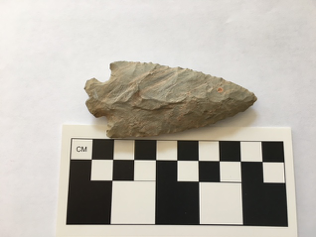Archaeology
The Wayland Historical Commission currently includes two members -- Tonya Largy and Amanda Ciaccio -- who are also members of the Wayland Archaeology Research Group (WARG). WARG is an arm of the WHC that works to identify, document and protect archaeologically sensitive sites and artifacts in Wayland.
Wayland Archaeological Research Group
Prompted by a town decision to build a soccer field on Alpine Road in 1977, avocational and professional archaeologists came together to form the Wayland Archaeology Research Group (WARG). Archaeologist Tonya Largy and Educator Barbara Robinson founded WARG with the assistance of many volunteers from the Elbanobscot Foundation. Barbara served as the first Coordinator, followed by Karen Langthorne, Paul Gardescu and presently, Tonya Largy. Additional members today include Amanda Ciaccio and Royce Kahler. Royce has volunteered for 25 years on excavations, laboratory work, and preparing reports.
Wayland has a number of archaeologically sensitive sites worth protecting. These sites are non-renewable resources holding valuable information from the first human occupation in Wayland. Native people came to the area some time after the glacier receded. In many instances, pre-contact occupation spans from the retreat of the glaciers some 10,000+ years ago. The historic period began with the English colonists in 1638 when Wayland was settled as Sudbury Plantation.
Since 1978, six excavations have been carried out under state permit by WARG, including an excavation conducted in the Fall of 2017 at the Dorey House, 107 Old Sudbury Rd. In addition to the field work, WARG contracted the services of Barbara Donohue to conduct a historical study and preservation management plan for Wayland’s North Cemetery, completed in 2015. Members of her team carried out a selective Ground Penetrating Radar survey and a gravestone assessment. The work of restoring and cleaning monuments in the 19th century section of the cemetery was carried out by Monument Conservation Collaborative, using Community Preservation Funds. See our section on Historic Cemeteries for more details.
 In the past four decades, we have learned much about Wayland’s history. One of the oldest artifacts in our collection, shown at right, is a bifurcated point found by a local resident while planting a tree on his property near Pine Brook. It dates to the Early Archaic period, some 8,000 years ago.
In the past four decades, we have learned much about Wayland’s history. One of the oldest artifacts in our collection, shown at right, is a bifurcated point found by a local resident while planting a tree on his property near Pine Brook. It dates to the Early Archaic period, some 8,000 years ago.
Two projectile points found here in Wayland have been classified as variants of the Susquehanna Broad Spear Point. (Justice, 1987) One, the Wayland Notch Point, dates to 3,700-2,700 B.P., (the Late Archaic to Early Woodland period). Another point, the Mansion Inn Blade, dates to a similar period and is from the Terminal Archaic period.
The Mansion Inn Blade gets its name from the Mansion Inn site, dug up by amateur archaeologists and local residents in 1959. An account of this event has been recorded by D. S. Byers in a January 1960 issue of American Antiquity. In addition, the Mansion Inn site was the main focus of a Harvard University Ph.D. dissertation written by Dena F. Dincauze and published by the Peabody Museum as a monograph entitled Cremation Cemeteries of Eastern Massachusetts. Cremains and culturally associated funerary objects are currently in the process of repatriation as outlined by the Native American Graves Protection and Repatriation Act (NAGPRA).
In order to add to our database of where sites were located, we invite Wayland residents to make an appointment to bring artifacts they might find on private property and provide information about your find.
Reports

